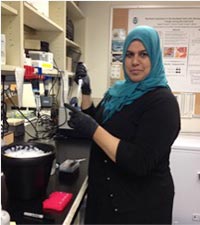
Name: Nada Rifai
Education: B.S. in Zoology at Tripoli University in Libya; M.S. in Biology at Yarmouk University in Jordan; currently working on her Ph.D. at CSU.
Hometown: Khoms, Libya
Career goal: Nada currently has a scholarship from her university in Libya that enables her to study and conduct research at CSU. She plans to complete her research and post doctorate here and then return to her home university and be a professor of science.
Favorite Memory: The most significant aspect of the Crab Lab for Nada is getting to work under a motivating research professor. “Dr. Mykles is very encouraging”, Nada says, “He makes me progress and want to learn.” He will listen genuinely to anything you have to say “whether it’s about research or not.” Dr. Mykles’ attitude towards his lab crew creates a very positive and welcoming atmosphere. “He is truly the symbol of our lab” Nada expresses with a smile.
Project: Identify, characterize and quantify the PDEs in the Y-organ (via transcriptome analysis, PCR, and gel electrophoresis techniques) then quantifying PDEs in different tissues of the blackback land crab (Gecarcinus lateralis).
Pieces of the Puzzle
Nada is studying a group of enzymes called phosphodiesterases, or PDEs. These enzymes play a vital role in regulating cAMP and cGMP–two very significant secondary messengers. Secondary messengers are molecules that carry messages to other parts of the cell. In order for different cellular processes to occur, the secondary messengers must work together with other enzymes and proteins like pieces of a puzzle, coming together to create a final product. The PDE enzymes interact with the secondary messengers and prepare them to do their job in the cell.
Fitting the Pieces Together
What is known for certain is that PDE enzymes interact with the cAMP and gAMP messengers, which directly effect their concentrations in the cell. What Nada is trying to prove in her research is that the concentrations of these messengers directly control the concentration of ecdysteroids, the molting hormones.
Nada is proving this relationship by first verifying that the PDE enzymes exist in the crab’s Y-organ via transcriptome analysis. After analyzing the gene sequence on a large scale she focuses on specified regions of the transcriptome by replicating, isolating, and characterizing specific sequences of DNA. Transcriptome analysis will give her a representation of the amount of PDEs in the Y-organ tissue.
Her next step is to examine different tissues of the crab, using the same techniques, thus quantifying the amount of PDEs in different areas of the body. By seeing where these enzymes are most active in the crab, Nada and other researchers begin to better understand the role of these enzymes in the molting cycle. Each component of Nada’s research serves as a missing piece of the molting puzzle. By putting these pieces together the whole picture starts to converge.
The Bigger Picture
Nada’s research, like all of the research being done in the lab, contributes greatly to our understanding of the molting process and how all the different components work together. In addition to playing a vital role in crab molting, PDEs are also studied for a variety of different applications, including recently becoming a big player in pharmaceuticals. Nada explains that increasing our knowledge of molting regulation could also apply to conservation tactics such as control of invasive arthropod species such as the Green Crab. This could benefit an array of lifestyles, from aquatic ecosystems to fishing businesses.
